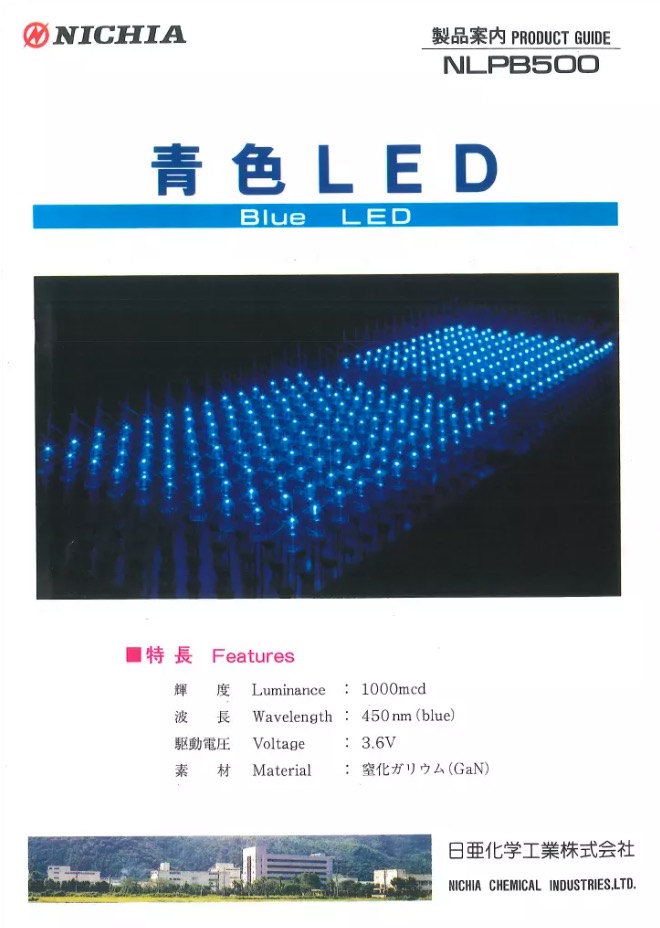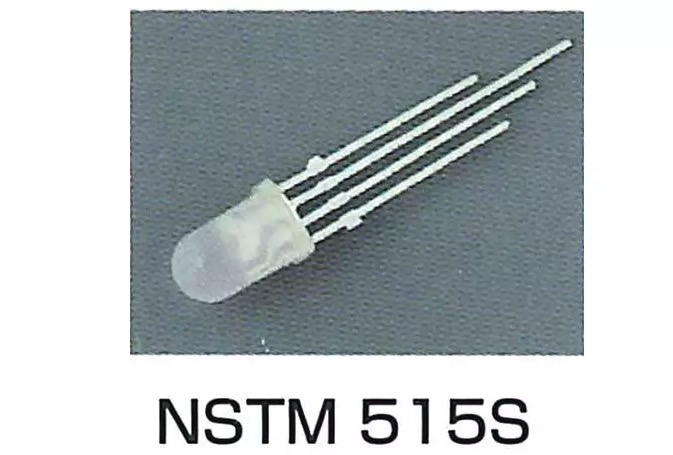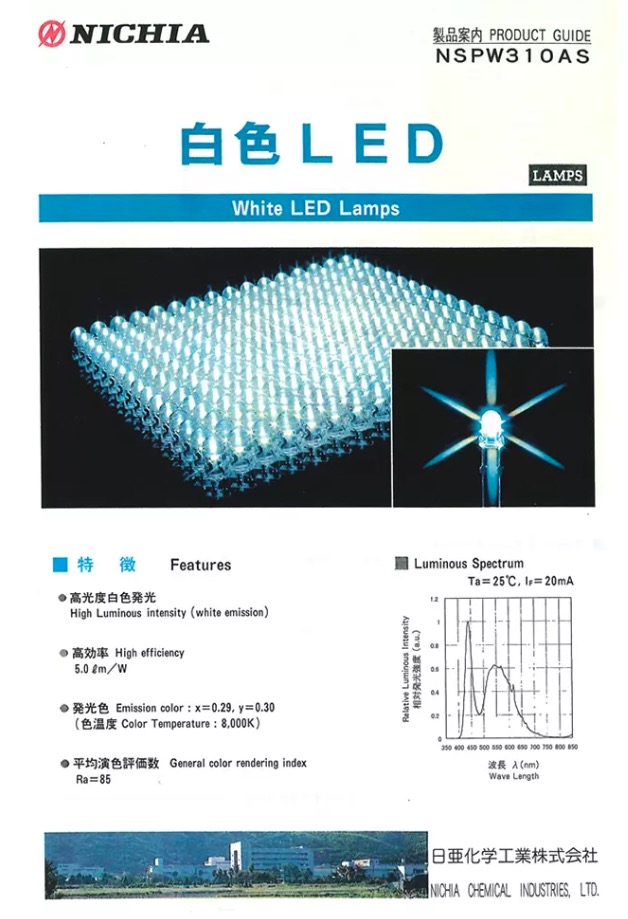30th Anniversary of the High Brightness Blue LED: Revolutionizing the Lighting Industry
- By Ledrise Led Professional
- Nov 21, 2023

It's been three decades since the introduction of high brightness blue LEDs, a pivotal moment in lighting technology. This innovation didn't just add a new color to the spectrum of LEDs; it revolutionized how we use light in our daily lives.
The blue LED has had a profound impact on the world. It paved the way for white LEDs, revolutionizing lighting, screen technology, and numerous other applications. This story about Nichia's blue LED, a product of a small-town company with big dreams, exemplifies how innovation can come from the most unexpected places and change the world.
The Launch of the Blue LED – A Small Announcement That Reached the Whole World
In November 1993, Nichia Corporation, then a relatively obscure chemical company nestled in the rural areas of Tokushima, Japan, was on the brink of a breakthrough. Known publicly more for its long summer vacations than its industrial contributions, Nichia was about to change the landscape of lighting technology.
A Modest Announcement
Contrary to the grandeur typical of tech product launches, Nichia's introduction of the blue LED was marked by simplicity. Eschewing lavish events, the company opted for an interview with the Tokushima branch of Nihon Keizai Shimbun, a prominent Japanese newspaper. This understated approach reflected Nichia's status and the skepticism they anticipated from the public and industry peers.
Aware of the potential disbelief in its claim of a blue LED "100 times brighter than conventional LEDs," Nichia meticulously prepared for the announcement. The strategy was to let the product speak for itself. Understanding the power of visual impact, the Nichia team prepared numerous working samples of the LED that could be lit up during the announcement. It worked, the market was impressed! The first blue LED was born, the Nichia NLPB500.

Market Strategy and Nichia's NLPB500
In the 1993 LED market, customization was king. However, Nichia chose a different path. Realizing the potential of the blue LED across various applications, they opted to market the first blue LED as a standard product. This decision not only streamlined their production process but also widened their potential market reach.
Nichia's first mass-produced blue LED, the NLPB500, boasted a brightness of 1000mcd – a stark contrast to the then-brightest blue LED from competitors, which stood at just 10mcd.
Cultural and Corporate Context
The launch of the NLPB500 was more than just a technological milestone; it was a cultural moment. Nichia's long summer vacations, a curious anomaly, were partly due to its employees' double lives as rice farmers. Coinciding with the rice harvest and local festivities like the “Awa Odori,” these vacations were as much a part of Nichia's identity as its products. The founder's passion for mountaineering and desire for extended breaks also played into this unique corporate culture.
Early Uses and Applications
Initially, blue LEDs found applications in traffic signals, displays, and scanners. These applications leveraged the distinct advantages of LEDs, such as energy efficiency, longevity, and robustness, in environments where these traits were highly valuable.
A significant leap was the expansion of LED technology into large screen display systems. Initially dominating outdoor spaces, these displays rapidly evolved. They found their way into stadiums, urban buildings for advertising, and eventually, indoor environments.
Challenges in Indoor Applications
Indoor applications posed unique challenges. The proximity of viewers to the screens necessitated a narrower LED pitch (the distance between each LED) to ensure higher image resolution and prevent graininess. Traditional LEDs were packaged separately by color (blue, green, and red), requiring significant space for mounting and limiting resolution enhancement.
Innovations by Nichia: The 3-in-1 LED that lead to the Birth of White LEDs
Addressing this limitation, Nichia Corporation's development of the first 3-in-1 LED was groundbreaking. By encapsulating three different color LED chips (red, green, and blue) in a single package, with the NSTM 515S LED it became possible to achieve higher resolution in smaller spaces. This innovation was pivotal for indoor display applications.

Commercialization and Impact of White LEDs
Interestingly, Nichia's 3-in-1 LED attracted attention beyond their targeted large display device manufacturers. Customers from various sectors showed interest, especially in the possibility of the LED to emit white LED. However, the technical challenges of obtaining a stable, uniform, white light from a combination of 3 color chips (R-G-B) lead to desiring of LEDs that emitted only white light.
Nichia had the innovative idea of obtaining a white LED by combining the blue LED technology with YAG phosphor, a field in which the company already had significant expertise. The first such white LED, the NSPW310AS was launched in 1996 and marked another turning point with far-reaching implications across industries, from lighting homes and offices to backlighting for TVs, smartphones, and other electronic devices.

The evolution of blue and white LED technology sparked a lighting revolution. Energy-efficient, long-lasting, and versatile, LEDs have become the preferred choice for various applications. Their impact extends to environmental conservation through significant reductions in energy consumption and carbon footprint.
Beyond Illumination: Emerging Applications
Today, LEDs serve purposes beyond illumination. They play critical roles in medical therapies, plant growth in controlled environments, and in purifying water. Their versatility continues to inspire innovations in areas like Li-Fi (light-based Wi-Fi), where LEDs are used for high-speed data transmission.
As we celebrate 30 years of blue LEDs, the journey is far from over. Ongoing research focuses on enhancing efficiency, color rendering, and miniaturization. Organic LEDs (OLEDs) and quantum dots are examples of technologies complementing traditional LED advancements, promising even more applications and efficiencies.
Celebrating a Bright Future
The 30th anniversary of high brightness blue LEDs isn't just a milestone; it's a testament to human ingenuity and the relentless pursuit of better technology. As we look forward, the potential of LED technology continues to expand, promising a brighter, more efficient, and sustainable future for all.





